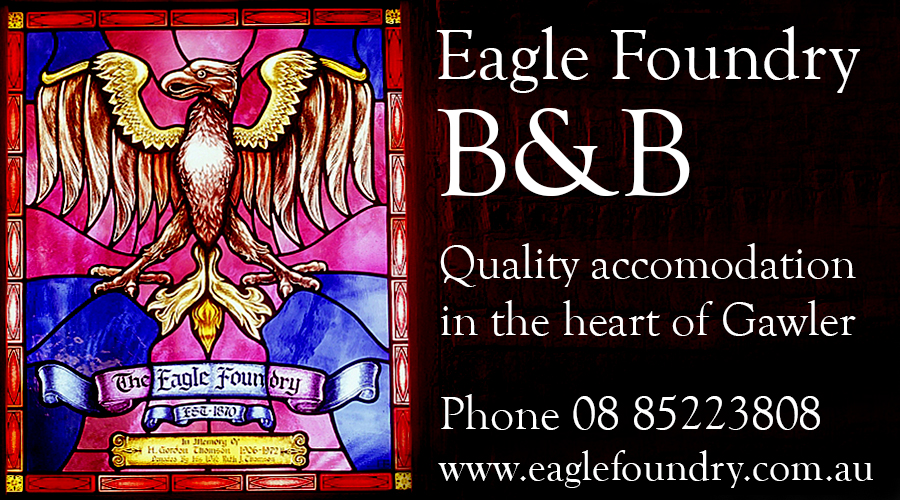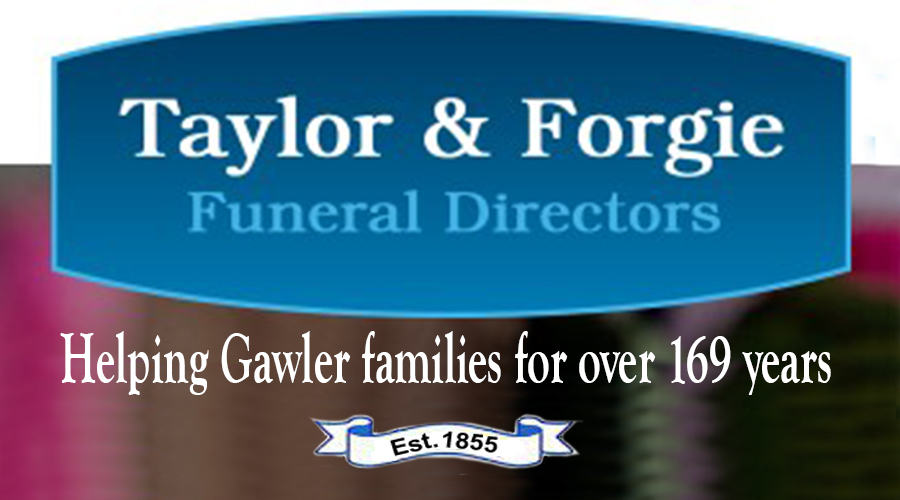Martin (Mayor) Hon James
| Type of person | Individual |
| Date of birth | 1821 |
| Place of birth | Foundry, Cornwall, England |
| Date of arrival | 1848 |
| Principal occupation | Manufacturer |
| Date of death | 1899 |
James Martin was elected as Councillor for Gawler's South Ward in 1857 to 1860. He was made an Alderman for those years. He was then elected Mayor of Gawler in 1861 to 1864 and elected Mayor again in 1868. He was elected as Councillor for North Ward 1874 and 1875. He was elected Mayor for 1877 and 1878 and then again 1886 and 1887.
George E.Loyau. "The Gawler Handbook" p52 James Martin "...left Cornwall, of which he is a native, in his 25th year, and arrived in Adelaide July 1st, 1847. He worked in the metropolis for eleven months, when he went to Gawler, and hired a blacksmith's shop from Mr. Henry Calton."
Derek Whitelock "Gawler" p63 "The young millwright [James Martin] who could turn his hand to anything met Henry Calton of the "Old Spot" who arranged to rent a workshop in Murray Street. He thought Calton "a very fine fellow....who owned a great deal of Gawler."
JAMES MARTIN
Born at Foundry in St. Stithians, Cornwall, England on April 23, 1821, to John and Jane Martin. His father, who died before his birth, had run the foundry which gave the village its name.
James had little education when he began work to help his widowed mother raise seven children. According to Robert Haysom's and Kenny Weller's research [RHr] as a youth he worked for a millwright named Hiplet in Truro and then in 1841, James worked at the Treseaven copper Mine in Gwennap. In 1842 he designed and built the first mine elevator [there were no plans given to him; just a rough sketch and verbal instructions]. This elevator was exhibited in the Falmouth Hall for the Polytechnic Society of Falmouth, won 1500 pounds for the Company and that amount covered one third of the cost of installing the machine in the Mine. He started at the Ponsanooh Woolen Mills and his asthma condition deteriorated.
James migrated to South Australia from Plymouth on 4th April 1847 on the “Belle Alliance”, with Thomas Martin, one of his cousins from Stithians who was a copper miner living in Treboast. [Thomas went to work in the Willunga slate mine]. One of the passengers on the ship was Christiana Fox.
[RSr] James Martin married Christiana Fox on 28th March 1848 at Holy Trinity Church in Adelaide, [Christiana was born in 1818] and James worked for John Ridley in Hindmarsh. [Ridley invented the famous Ridley reaping machine].
James Martin arrived in Gawler on June 15, 1848 with a dray containing his young wife Christiana, some furniture and a few tools, and commenced business in the town. He rented some land from Calton and his first job was to cut down a large tree and, from it he made work benches and a lathe. James commenced building bullock drays but by 1852, he started the manufacture of agricultural implements; primarily reaping machines. Around this time he was able to employ about 30 men which meant a considerable expansion of his premises.
On 16th December 1850, James and Christiana had a son, John. John was to be called "Captain Jack" in his lifetime. [On 27th December, 1882 in St Georges Church in Gawler, John married Adelaide Isabel Annie Parr who was born on 5th March 1851 and died in 1933. Adelaide's mother was Mrs Joseph Freake. John died in 1925.]
Unfortunately Christiana passed away on 16th April 1852 when giving birth to their daughter, also named Christiana. His wife was buried in the Town of Gawler cemetery [in what is now Pioneer Park]. Their daughter Christiana was Baptised in St Georges Anglican Church and sadly died [from "decline"] at the age of 2 months and 10 days and, on 20th June 1852 was also buried in the Town of Gawler Cemetery.
Eleven months later, on 6th March 1853, James then married 34 year old Ann Lock (born 1818 and daughter of J. Lock from Dartmouth, Devon) in St Georges Church, Gawler, but she died during childbirth on 7th December 1853 and was buried on 9th December 1853 in the Town of Gawler Cemetery.
On August 2, 1858, in Christ Church North Adelaide, James married Charlotte Vickerstaff Bradley, [born 1819] who was the widow of the first Publican of the Gawler Arms Hotel. She survived until age 75 and died on 7th November 1894.
[RHr] In 1860, his brother Felix [born 23rd May 1813 in Stithians, Cornwell] arrived in Gawler with his son John [born 14th August 1844 in Stithians and who married Christina McNeil and John died in 1916] and Felix died in that year. James became John's Guardian.
That year James became a Master of the Lodge of Fidelity and continued in that position until 1870. In 1857 he was Alderman in Gawler's first Council. In the years 1858 -1860 and 1867 James was President of the Gawler Institute. Becoming Mayor of Gawler in 1861, he also became Vice-President of the Gawler AH&F Society, Director of a Building Society and in 1863 became President of Gawler AH&F Society [as well as 1864, 1869, 1874 and 1877] and in 1864 became a JP.
In 1866, James built his home "outside of town", calling it "Trevu".
Thomas Loutit entered into partnership with Mr. James Martin in 1858, which lasted until 1868 when it dissolved as a consequence of Thomas’ deteriorating health. While working with Mr. Martin, he introduced steam power, and improved machinery, which helped lay the foundation of Gawler’s reputation for engineering. The partners set up the Phoenix Factory, which enabled the firm to extend its range of production, as farming was expanded in the Gawler region. They were one of the leaders in this type of industry in Australia at the time.
In 1869, James presented the land [now 91 Murray Street] to establish the Gawler Institute building and in 1870, the Institute foundation stone was laid by Governor James Fergusson.
In 1874, Fred May and John Felix Martin were taken into partnership with James. On 17th October, a serious boiler explosion sent the end of a boiler across the road into the garden of James Harris [land on the NW corner of High Street currently occupied by Centrelink].
In 1880, James returned to England for 10 months, returning with plan to manufacture railway locomotives. In this year, John Martin died [James' eldest brother], and the first railway wagon was built and in 1881 a tender was accepted for the building of 200 railway wagons. In 1883, James became a member of the Gawler Racing Club. On 4th March 1885 his partnership with Fred May ended and on 8th May, James was elected Member of the Legislative Council and retained that position until 1899.
Possessing a natural ability with anything mechanical, James built his business up to such a degree that at one time he employed around 700 men on a property that covered 18 acres. Starting with farm implements, he then produced mining machinery and finally railway locomotives and rolling stock.
In 1888, his tender was accepted by the SA Government for the manufacture of 47 locomotive engines for a contract price of 167,000 Pounds, The first locomotive was delivered 11th April 1890 and he then secured a contract for another 92.
In March 1891, the SA Cornish Association was formed in Gawler with Hon James Martin M.L.C as President.
By 1892, James was employing 700 men in Gawler. James was responsible for building 268 locomotives and these were sent all over Australia.
In 1893 James was elected member of the Gawler School of Mines Council and he was a Co- Trustee of the St Georges Church Fund, and in 1850 was Co-Trustee of the Gawler Methodist Church and supporter for the building of the Presbyterian Church. He was a Committee Member of the Gawler Bible Society, Gawler Race Club, Captain of the Gawler Rifles and from 1873 was a member of the Gawler Club.
On 23rd December 1894 the 100th Locomotive was built. On 15th June 1898, 1500 people were at a celebration at Gawler Oval in honour of James living 50 years in Gawler.
James Martin seemed to have a hand in almost every Gawler venture, and beside his eight years as Mayor [in 1861 - 1864, 1868, 1877 - 1878 and 1887], he was the Member for Parliament for the Barossa from 1865-1868 and a Member of the Legislative Council from 1885 until his death on December 24, 1899.
One of the founders of the Institute – he donated some of the land for the building – he laid the foundation stones of the Gawler Primary School (April 12, 1877), and the Town Hall (April 16, 1878). He was a Committee Member for the Queen Victoria Diamond Jubilee celebrations.
Gawler’s most famous “father”, James Martin served the town well, and helped establish Gawler after the hard times, when, after only six men were left in the town through the 1850s gold-rush, his enterprise gave work to many people to help build a thriving community.
An alderman on Gawler’s first council in 1857, James Martin is regarded as the father of Gawler.
James Martin died 27th December 1899 and a special train ran from Adelaide to convey mourners to the funeral. His funeral procession towards the Willaston Cemetery was one mile long. The funeral service finished before the last of the procession arrived at the Cemetery.
A statue of him, made of white marble, was erected on the corner of Calton Road and Murray Street on 15th August 1903 and unveiled by Sir Samuel Way. On 2nd June 1969, it was shifted to proudly stand tall in Whitelaw Terrace. It was cleaned and repaired in 2014, the year Gawler was celebrating its 175th year.
Evidently his sister Jane organised for a memorial to be erected in the Stithians Parish Church to honor James.
James estate amounted to 27,000 pounds [equivalent to about $4 million in 2017] and it included land which he left to his son John, a farmer, and his business went to his nephew John Felix Martin.
James Martin's Last Will and Testament has been scanned and appears when one clicks onto the "photos of James Martin" link below.
An oil painting of Mr. Martin, which was presented to the Institute in the 1860s, remains in the Gawler Library, and on 17th August 2017 a further painting of James Martin was presented to Town of Gawler by the Lodge of Fidelity.
The following summary of the life of James Martin was presented to John Dawkins MLC by the South Australian Parliament Research Library in 2018.....
"Apprenticed to a millwright, the young James Martin had little formal education. Despite the status of his education, he showcased a tremendous talent for innovation, which was first shown by his involvement in the invention of a 'man engine': a kind of elevator, which was widely adopted in the hazardous mines. As a blacksmith, he could turn his hand to anything and the quality of his work, once recognized, lead him into the manufacturing of farming tools, bullock drays and iron work. Soon his company - James Martin & Co. - had spread to other towns including Quorn and Gladstone. He won a Government Contract in 1888 to construct 52 locomotives after James Martin & Co. expanded, introducing railway rolling stock into the business. His trains were beautifully designed and served to launch James Martin & Co to the peak of its success.
Martin was elected Mayor of Gawler several times and was a leading member and patron of most of the town's organisations. He represented Barossa in the House of Assembly in 1865-68 and North-Eastern Province in the Legislative Council in 1885-99.
In 1865 he had supported Goyder's valuations of the pastoral runs and in 1885 a protective tariff, both popular causes, but by 1894 he had moved to the right. On the hustings he criticized the Labor Party and favoured the programme of the conservative National Defence League which endorsed his candidature.
His greatest parliamentary achievement was to secure the construction of the Barossa reservoir which supplied Gawler with water from 1902. In 1903 a statue with the inscription 'A tribute to his public worth' was placed in the town's main street; it now stands in a park on the banks of the South Para River."
George E. Loyau "The Gawler Handbook" [G.E.L.] pp166 and 167 "After McKinlay's death it was universally felt that something should be done to perpetuate his memory, and accordingly, meetings were held in Gawler and a Committee was formed to carry out the wish of the people - vis., that a suitable monument should be erected "to commemorate his personal worth and the services rendered by him to the colonies as an explorer." The site selected was at the terminal point of Murray-street, at its junction with Cowan-street, and adjacent to the old burial ground. The Committee chosen to carry out the matter, and who brought it to a successful issue, were as follows:- Chairman, W.F. Wincey, Esq., J.P., Mayor of Gawler; Treasurers, J. Thornley, Esq., J.P., Manager Bank of South Australia, Gawler, Richard Holland, Esq., J.P., Turretfield, near Gawler; Hon. Secretary, John Rudall, Esq., Gawler; Committee, A.H.F. Bartels, Esq., Mayor of Adelaide, E.M. Bagot, Esq., J.P., Charles Bonney, Esq., J.P., E.S. Burkett, Esq., J.P., W.R. Cave, Esq., John Chambers, Esq. ,J.P., Rev. Canon Coombs, Hon. J. Crozier, M.L.C., Walter Duffield, Esq., J.P., James Dawson, Esq., Samuel Davenport, Esq., J.P., James Fergusson, Esq., Robert Fotheringham, Esq., Thomas Fotheringham, Esq., Rev. James Gordon, Joseph Gilbert, Esq., J.P., F.A.Grant, Esq., J.P., E.L. Grundy, Esq., John Hope, Esq., Thomas Hogarth, Esq., J.P., G.W. Hawkes, Esq., S.M., J.H.Howe, Esq., Joseph Keynes, Esq., J.P., Hon. A.B. Murray, M.L.C., Rev. J.C. McMchael, James Martin, Esq., J.P., John Mitchell, Esq., J.P., H.T. Morris, Esq., J.P., W.F.H. Popham, Esq., M.D., Ross T. Reid, Esq., Henry Scott, Esq., J.P., Dr. Schomburgk, H.C. Swan, Esq., S.M., R.J. Turner, Esq., S.M., and George Warren, Esq., J.P.
Please click here to read reference to James Martin on pages 10 and 11 in Gawler's Cemeteries, researched by Anne Richards. [This link is not accessible 3/2019 - Gawler Council is endevoring to remediate all such links]
Click to read more information about James Martin on the Town of Gawler website:
Click here to read "A Tale of Two Lathes - By Peter Hoye
Please read the thesis by Patricia Sumerling - The Old Spot Hotel, Gawler: a development history - We also thank Bruce Harry of Bruce Harry Architects for also giving their permission for this historical report to be published.
Please click here to read “Economic Time, Technological Space: A spatial analysis of capitalism at the Phoenix Foundry 1847 - 1928 -- Alan Hay Bachelor of Archaeology (Honours) Thesis - October 2009”
While this publication comprises of 182 pages, the Birth of the Foundry and its subsequent usage commences from page 43.
Historic Gawler Train Restored 2019 - James Martin Bunyip Article
Please click here to see photos of James Martin.
<Click here> to read Memories of Gawler 1923+ by Colin Hillier re James Martin Foundry etc.
Related Articles
- James Martin Memorial restoration October 2014
- James Martin Phoenix Foundry
- James Martin Phoenix Foundry Site
- Mayors of Gawler
- James Martin Phoenix Foundry Subsequent Useage
- James Martin Phoenix Foundry Strike
- James Martin's Mine-Winding Machine
- Old Spot Hotel 77 Murray Street
- Gawler Arms Hotel 102 Murray Street
- Martin Charlotte Vickerstaff Bradley
References
Memories of Martin (Mayor) Hon James
Do you remember Martin (Mayor) Hon James ? Then Join up and add your memory here.










